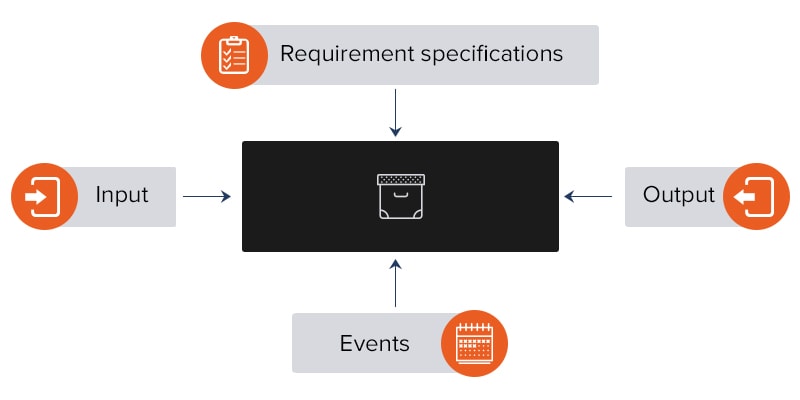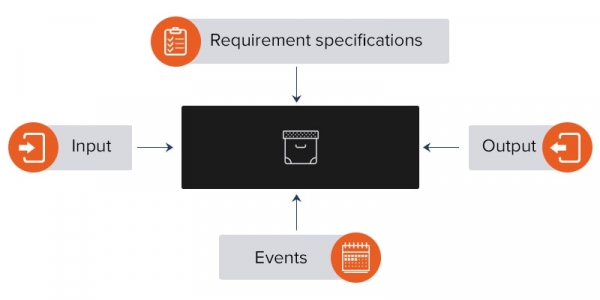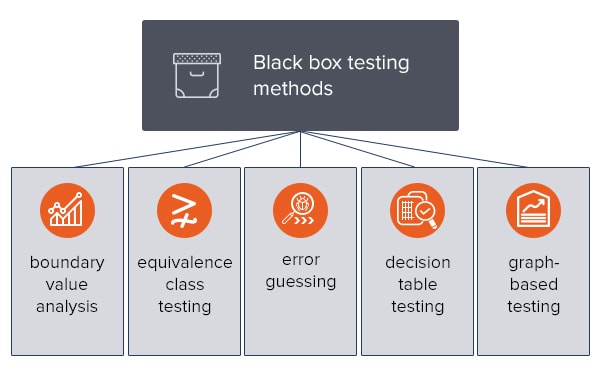
If to formulate the concept of black-box testing in one sentence, it may have such interpretation: we see what users see without internal path knowledge and internal code structure of the software. In fact, black-box testing is a technique used to verify software functionality working exclusively with the external interface. This testing method is also referred to as behavioral testing and functional testing.
Why exactly a "black box"? As the name suggests, QA specialists work with software that is like a black opaque box, the contents of which no one sees. The purpose is to detect errors in the interface, system behavior; discover incorrectly implemented or missing features; errors in data structures, or wrong organization of access to external databases.
Schematically, black box testing can be represented in the following way.

As you can see, the QA specialist doesn’t have to dive into the internal processes of software. According to the approach, only inputs and outputs are verified. The black-box technique does not focus on internal code and the specifics of its implementation. This means that database testing is not performed, and a verification process is independent of tools, platforms, development models, etc.
Algorithm of black-box testing
In general, the procedure of black-box testing includes the following steps:
- Examination of initial software requirements and project specifications
- Selection of valid inputs for positive test scenarios and invalid inputs for negative ones
- Expected outputs determination for both positive and negative test scenarios
- Test cases preparation with all the determined inputs
- Execution of ready test cases
- Comparison of actual results with expected ones
- Retesting after bug fixing if any
The black box approach can be applied throughout the whole software development life cycle. It can be used at the unit, integration, system, acceptance, and regression testing stages. In most cases, the system is verified in the production environment to evaluate the software from the end-users’ perspective. But the environment can be simulated if it is too difficult to execute real-life test scenarios in laboratory conditions.
Test data definition
As the number of possible inputs can be too large, testing all of them is not viable. Thus, several techniques are applied to select proper test data and ensure adequate test coverage. They are:
- Boundary value analysis based on verification of only extreme boundary values, e.g., maximum, minimum, and typical
- Equivalence class testing based on checking one value within one input class
- Error guessing based on the previous experience of a QA engineer
- Decision table testing based on a tabular representation of combinations of inputs and correspondent system behavior
- Graph-based testing where a test case is written for each graph that represents the object.

Types of black-box testing
As there are functional and non-functional software requirements, black box testing can be both types. The functional type focuses on the verification of system behavior under certain conditions. For example, it can be authentication and authorization, notification features, business rules, etc.
Non-functional black box testing, on the other hand, verifies such software attributes as performance, reliability, security, maintainability, usability, interoperability, and others.
Takeaways on black-box testing
- To perform black-box testing, a QA engineer should not have great technical and coding skills. A tester can perform software verification without knowing the specifics of the system architecture and development process. Black box testing is suitable for non-technical testers.
- As the black-box technique is based on available software requirements and specifications, it is a way to prove that the system performs the functions only it is supposed to do and does not conduct any functions that contradict the requirements.
- A QA engineer can write test cases for black-box testing as soon as a functional specification is ready. It accelerates the process of quality verification.
- Since black-box testing monitors and examines software from the customer's perspective, it is the right path to release a product that users purchase.
...
If your product requires testing, we are ready to hedge your team and ensure the high quality. Feel free to contact us for collaboration. Let's make great products together.
